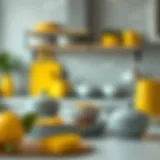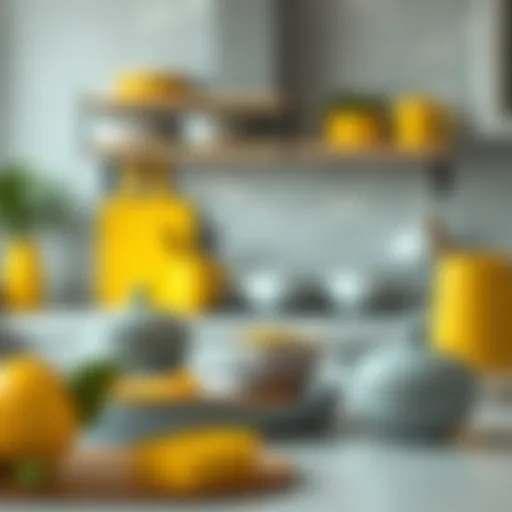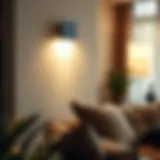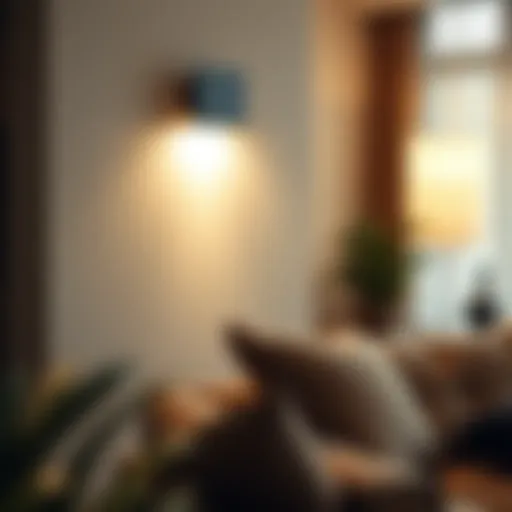Designing the Perfect Stuffed Animal Bin for Your Home
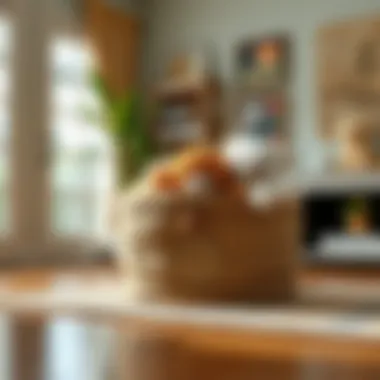

Intro
When creating the perfect space for your beloved stuffed animals, it's easy to overlook one critical element - the bin itself. A well-designed stuffed animal bin does more than just hold toys; it can enhance the overall aesthetics of your home while offering practical solutions for tidiness. As you might imagine, several key factors come into play when determining what makes an ideal stuffed animal bin. It's about striking a balance between style, functionality, and durability. In this guide, we will explore various design considerations, embodying trends in furniture styles, material choices, and maintenance routines that will elevate your stuffed animal storage game.
Furniture Styles and Trends
Modern vs. Traditional: Understanding the Aesthetics
In the world of furniture design, styles can often feel like opposites. Modern bins often flaunt sleek lines, minimalistic designs, and an understated elegance. These bins could feature clean shapes crafted from durable materials such as polycarbonate or high-density foam. They align with contemporary aspirations towards functionality and efficiency in space utilization.
On the other hand, traditional bins embrace a warmth and comfort that resonates deeply with nostalgic aesthetics. Think of wooden bins with ornate carvings or fabric-covered boxes featuring charming patterns. These options infuse a cozier feel into children’s rooms, while often boasting a timeless charm that can harmonize well with more classic home decor.
"The right stuffed animal bin reflects your unique style while serving its main purpose in the most practical way possible."
Color and Material Trends: What's In and What's Out
Navigating color trends can feel like a moving target, yet certain shades consistently find their way to the forefront. Earth tones such as terracotta and olive green are making waves, providing a warm and inviting feel. At the same time, pastels still hold a tender place in many hearts, especially in children's spaces.
In terms of materials, sustainability is key. Bins crafted from recycled or eco-friendly materials are not only advantageous for the planet but also gain favor among homeowners looking for responsible choices. Bamboo and recycled plastics are becoming increasingly common, offering durable options without compromising ethical sourcing. Meanwhile, textile storage bins using soft fabrics can provide added functionality, as they are generally lighter and more portable, aligning with modular living needs.
Furniture Care and Maintenance
Tips for Prolonging the Life of Your Furniture
To ensure your stuffed animal bin stands the test of time, a few quick care tips might go a long way:
- Regular Dusting: A simple wipe-down can keep surfaces clean and maintain visual appeal.
- Avoid Direct Sunlight: Prolonged exposure can cause colors to fade or distort.
- Water Resistance: If possible, opt for bins with water-resistant finishes to prevent damage over time.
DIY Repair Hacks for Common Furniture Issues
Every now and then, bins might face scratches or minor dings. Repairing them doesn’t have to be rocket science:
- Use wood filler for a quick fix on wooden bins. Apply it, sand it smooth, and re-stain if necessary.
- For fabric bins, a simple sewing kit can repair rips or seams that give way.
- If a plastic bin gets a crack, super glue or adhesive specifically designed for plastics can work wonders.
Finale
When considering the design of an ideal stuffed animal bin, grasping the trends and styles available is vital. It’s not just about storage; it's about creating an inviting atmosphere for children and sharing their special items with the world. In this quest for a well-designed bin, understanding the aesthetic connection with functionalities ensures a beautiful, organized, and meaningful home space. Incorporating practical advice on care and maintenance only makes it better, allowing you to cherish your investment for years to come.
For more insights on furniture design and organization, feel free to check reputable sources like Wikipedia, and Britannica.
Understanding the Role of Stuffed Animal Bins
Stuffed animal bins may seem like just another organizational tool, but their role extends far beyond mere storage. In the world of child-rearing and home management, specially designed bins serve multifaceted purposes. They provide a designated space for toys, helping to maintain order amidst the delightful chaos that children often create. Beyond simple clutter control, these bins also contribute to a child's development by fostering skills such as tidiness and responsibility. When children engage in organizing their belongings, they learn valuable lessons that extend beyond their plush friends.
A crucial element in the effectiveness of stuffed animal bins is their aesthetic value. Often, they can contribute significantly to a room's overall design, merging functionality with style. Parents looking to create inviting spaces often find that a well-chosen bin can enhance the visual appeal of a room while seamlessly fitting into existing décor. This prompts a closer examination of materials and colors, indicating that organization and design go hand in hand.
In understanding the role of stuffed animal bins, it is also essential to consider the emotional comfort they can provide children. Stuffed animals are not merely toys; they often represent companionship or security. A bin designed to house these comforting items reminds children of their importance while also encouraging them to take an active role in caring for their belongings.
Furthermore, effective organization through the use of stuffed animal bins can promote ease of access. When children know precisely where to find their plush friends, it becomes easier for them to engage in imaginative play. This leads to creativity and independence, fundamental elements in child development. Contrary to the belief that organization stifles creativity, it can actually lead to more vibrant and uninhibited play experiences.
By properly addressing stuffed animal storage, we can see its role encompasses not only the practical aspects of home life but also emotional and developmental considerations for children. The interplay between organization, design, and functionality illuminates why stuffed animal bins are important components of daily family life.
Types of Stuffed Animal Bins
In the quest to efficiently manage stuffed animals, understanding the different types of bins available is vital. Each type serves unique purposes and meets specific preferences, shaping how we organize and display these cherished toys. Selecting the right bin is not just about aesthetics; it involves considering usability, safety, and the overall space in which the bins will reside. Here, we delve into various types of stuffed animal bins that anyone might consider for their home.
Fabric Bins
Fabric bins have become increasingly popular due to their soft texture and lightweight nature. These bins often come in a variety of colors, patterns, and designs, making them a versatile option for different rooms. They can be easily folded and stored away when not in use, thus allowing flexibility in organizing space. Durability is a key factor; one may want to look for bins made from sturdy materials like canvas or cotton blends. However, it's worthwhile to remember that fabric bins might require more frequent cleaning, especially if they're used in high-traffic areas.
Some common attributes include:
- Variety of designs: Users can match patterns to room aesthetics.
- Lightweight and portable: Easy to move around.
- Soft edges: Safer for children.
Despite their advantages, a downside is the potential for dirt accumulation, which means owners must be diligent about upkeep.
Wooden Bins
Wooden bins often convey a sense of permanence and sturdiness. They are typically well-crafted and can seamlessly fit into both traditional and modern decors. With the use of high-quality finishes, wooden bins can be both beautiful and functional. They tend to hold up better over time compared to fabric or plastic alternatives, but one must take care to choose bins that are free from harmful chemicals and safe for children's use. The overall weight may be a consideration as wooden bins can be heavy, which might not suit every household's needs.
Key advantages of wooden bins include:


- Durability: They can withstand years of use.
- Aesthetic appeal: Wood adds a warm, natural element to any room.
- Customization: Many people can personalize their bins by painting or staining them.
However, wooden bins can be pricier than other options, and maintenance to prevent scratches or water damage can be needed, posing a challenge for some households.
Plastic Storage Solutions
When it comes to versatility and affordability, plastic bins often take the cake. They provide a robust storage solution that resists moisture and easy cleaning. The see-through designs allow for easy identification of contents, reducing the time children spend rummaging through their collection. Thoughtful features, like lids or stackable designs, can optimize vertical storage spaces, which is crucial in smaller rooms.
Benefits of using plastic storage solutions include:
- Affordability: They can be quite cost-effective.
- Water-resistant: Ideal for damp environments.
- Lightweight and sturdy: Easier to handle than many wooden counterparts.
One must pay attention to quality, as cheap plastic can warp or fade over time. Additionally, parents should ensure the bins are BPA-free to guarantee child safety.
DIY Options
For homeowners looking to infuse personal style into their stuffed animal storage, DIY options can be a fantastic solution. Constructing bins from repurposed materials not only reduces waste but also fosters creativity. Whether it’s an old laundry basket, wooden crates, or fabric remnants, there are countless ways to make unique bins that are tailored to your needs. This route allows for a custom fit, both in size and aesthetic. However, it is essential to consider the time and effort needed to construct these items, as well as ensuring that they are safe and functional for children.
Why go the DIY route? Here are some advantages:
- Customization: Perfect for matching any home decor.
- Sustainability: Encourages recycling materials.
- Cost-effectiveness: Potentially saves money compared to store-bought solutions.
Nonetheless, those opting for DIY might require some tools and skills, which may not be accessible for everyone.
In summary, each type of stuffed animal bin has distinct advantages and considerations. Homeowners can select a bin that not only fulfills practical requirements but also adds a touch of personality to their living spaces.
Choosing the Right Material
Selecting the right material for a stuffed animal bin is arguably one of the most crucial aspects in the design process. The material choice can impact durability, aesthetics, safety, and overall user experience. Each type of material brings its own set of characteristics that will suit different households and personal tastes. When considering how your stuffed animal bin will fit into your lifestyle, keep in mind the nuances of each material and how they align with both practical needs and style preferences.
Durability Considerations
Durability is king when it comes to stuffed animal bins, particularly in homes with young children or active lifestyles. The chosen material should withstand the test of time as well as the wear and tear that comes with everyday use. For instance, fabric bins may offer a soft touch, but they are often less durable compared to wooden alternatives. Hence, one may need to pick fabric that is specifically designed to be wear-resistant, such as ripstop nylon or canvas, which can endure frequent handling without losing shape or integrity.
Wooden bins, on the other hand, are robust and can serve as a long-lasting part of your home decor. However, one should ensure they are made of high-quality wood and treated properly to avoid splintering or warping. Investing in solid construction not only ensures longevity, but it can also add an elegant touch to any room.
"Choosing the right material is not just practical; it's a balancing act of function and aesthetics."
Aesthetic Factors
Aesthetics go a long way in making a stuffed animal bin blend seamlessly into the living space. The right material can invite warmth and charm, turning a simple storage solution into a stylish accessory. Fabric bins often come in a variety of colors, prints, and textures, making it easy to match them with existing decor. For instance, a pastel-colored fabric bin might complement a child’s room filled with similar tones, while a bold geometric print could serve as a striking statement piece.
Moreover, wooden bins offer a classic appeal that can align with various decor styles, from rustic to modern. The natural grain and finish of wood can add visual depth, creating a more inviting situation for storage. However, paint or varnish options should also be considered as a means to customize the appearance further, ensuring it doesn’t clash with the rest of the room.
Safety and Child-Friendliness
Safety is paramount in any home, especially when children are involved. The right materials should prioritize not only functionality but also child-friendliness. With fabric bins, look for non-toxic fabrics that are also washable, as children can certainly get messy. Soft edges and rounded corners reduce the risk of injuries during rough play or when bins are knocked over.
For wooden bins, ensure that any finishes are free of harmful chemicals and comply with safety standards. Smooth surfaces are essential to avoid splinters and injuries. While choosing materials, it's also wise to consider the bin's stability. A top-heavy wooden structure may risk tipping over, while fabric bins can be better at absorbing impact due to their flexible nature.
In summary, choosing the right material for your stuffed animal bin is not simply about deciding between wood, fabric, or plastic. It's a comprehensive thought process that examines durability, aesthetics, and safety, all while serving the function of keeping your child's treasures organized.
Design Trends in Stuffed Animal Bins
When it comes to the storage of stuffed animals, trends in design not only reflect aesthetic preferences but also address functionality, user comfort, and environmental consciousness. This section delves into modern styles that play a crucial role in home organization, meeting both the needs of the space and the hearts of those who inhabit it. With children’s rooms increasingly becoming a canvas for creativity, it's vital to acknowledge how design plays a part in enhancing both storage solutions and the room's overall ambience.
Minimalistic Design
Minimalism has taken the world by storm, embracing simplicity and functionality. A minimalistic stuffed animal bin cuts through the clutter, allowing toys to be to neatly tucked away without overwhelming the room's visual appeal. This approach chooses soft, neutral colors and clean lines, which cultivate a sense of calmness. Parents have found that bins like these work wonders—not just as containers, but as aesthetically pleasing decor that fits in seamlessly with the rest of the room.
The draw of minimalistic design lies in its versatility. You can place these bins in any corner or position them under a bed. Consider, for instance, a canvas storage bin in a light beige color. It’s not just practical—it can fit perfectly next to a bookcase or in a child’s reading nook. By opting for this style, the organization doesn’t have to scream practicality; it can be subtly integrated into the decor.
Eco-Friendly Alternatives
With the rising awareness regarding environmental issues, many homeowners are leaning towards sustainable options for their stuffed animal bins. Materials derived from recycled sources—like reconstituted wood, biodegradable fabrics, or sustainably harvested bamboo—are gaining undeniable traction. These eco-friendly storage solutions not only provide a way to store beloved toys but also underscore a commitment to the planet.
Choosing eco-conscious materials means making thoughtful decisions. These bins not only serve a purpose but contribute to nurturing a green lifestyle. A bin made from organic cotton can double as a soft seating option for your little one. Search for products that are devoid of harmful chemicals, ensuring safety for children while being gentle on the earth. It’s a win-win situation where personal responsibility meets conscious living.
Adaptable and Multi-Functional Bins
Adaptability is key in today’s ever-changing world, especially when it comes to home organization. Multi-functional stuffed animal bins have emerged as a trend that addresses the need for efficiency without compromising style. These bins often come equipped with various compartments, allowing children to sort their toys based on size, type, or even color. Some may even have flip-top lids or convertible options to transform into seating or tables.
Think about a sturdy, woven bin that not only keeps plush toys in check but can easily act as a seat when friends come over for a playdate. Other designs may feature pockets for small items, which gives children responsibility in organizing. This fosters not just tidiness but also creativity in play. Utilizing bins like these taps into the desire for functional spaces while still allowing for a carefree environment—important for both parents and children alike.
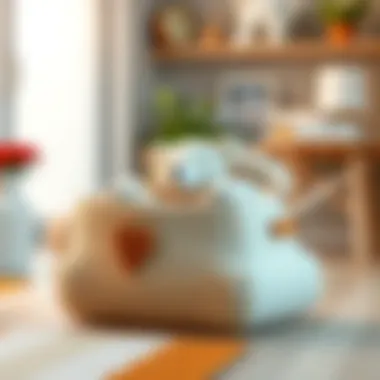

Practical Interior Design Tips
When tackling the challenge of stuffed animal storage, the details of practical interior design can't be overstated. This section delves into practical matters that not only enhance the functionality of the bins but also ensure they align seamlessly with your overall home aesthetic. It’s about finding that sweet spot where utility meets style, making your home both livable and visually appealing.
Incorporating Bins into Existing écor
Fitting a stuffed animal bin into your existing décor involves more than just picking a container that seems to match. You need to consider color, texture, and overall style of your room. For instance, if your living room boasts a contemporary vibe with clean lines and neutral tones, opt for bins that echo these elements. A sleek, minimalist fabric bin in a soft gray could tie the whole room together.
On the other hand, if the nursery is bursting with vibrant colors and whimsical patterns, bins featuring bold prints or bright shades can complement that energy beautifully. Think of it this way: the stuffed animal bin doesn't have to be an afterthought that clashes with the surroundings; it should be a coherent part of the visual narrative your space tells.
When selecting places to position these bins, be strategic. Corners or under benches can serve well without crowding the area. An open shelving unit, for example, can be an engaging way to showcase the bins while keeping them accessible. Use materials that resonate with the surrounding furniture - wood bins paired with wooden bookshelves add warmth and cohesion, whereas metal bins might lend an industrial edge to more modern environments.
"The key to cracked harmony in home décor lies in the way objects converse with each other."
Space Optimization Techniques
Making the most of available space is crucial, especially in homes where square footage is at a premium. Stuffed animal bins shouldn’t just serve a functional purpose; they should also maximize the area available. For example, consider integrating bins into existing furniture, like a bench with built-in storage. This dual-purpose piece can provide seating while also hiding away stuffed animals, neatly solving two problems at once.
Another tip? Think vertical. Floor space can be limited, but walls are often underutilized. Wall-mounted shelves can host lightweight bins, keeping the plush toys out of the way but still easily accessible. Not only does this technique optimize space, but it also adds a layer of visual interest to the room.
Don’t forget about multifunctionality. Bins that can also double as side tables or decorative accent pieces can save valuable real estate. Use baskets that can add texture or color while still being practical—shoot for options that harmonize with your overall design and remember they don’t have to sit idle when not in use; they can serve as decorative elements in their own right.
Finally, develop a habit of routine management. Reassess the stuffed animal collection periodically. By eliminating those that are seldom used, you can make the most of smaller spaces and avoid overwhelming the bins. The goal is to maintain an effective organization system that achieves both aesthetic appeal and functional efficiency.
Organization Strategies
When it comes to managing a collection of stuffed animals, organization is key. A strategic approach can streamline access and preserve the items’ condition. Not only does a methodical organization system keep a room tidy, but it also enhances the overall aesthetics. By creating an organized system, you empower children and caregivers alike, promoting independence and responsibility.
One crucial element in developing an effective organization strategy involves understanding that not all stuffed animals are created equal. Varied sizes, textures, and age appropriateness can dramatically affect the ease of access and usage. By sorting stuffed animals into categories—by size and age—it creates a more user-friendly environment. Imagine a scenario where a child has a specific craving for a big teddy bear but has to sift through assorted plush toys, or perhaps a younger sibling operates in the same space. The difference between organization and chaos can often be represented by how quickly one can locate the desired item.
Another vital aspect of organization strategies is the incorporation of labels and markers. It’s not simply about categorizing; it’s also about making that categorization clear. A well-placed label can save time and prevent frustration, especially in shared spaces. There’s a certain delight in seeing neatly labeled bins, indicative of care and intention. This further encourages a sense of ownership, making it more likely that children will put their toys back where they belong. The benefits of well-thought-out organization strategies extend beyond mere practicality, inviting a nurturing ambiance in play spaces.
Organization isn’t just a trend; it’s a lifestyle choice. It reflects on individual habits, values, and the atmosphere maintained at home. Investing time into developing a suitable organization strategy for stuffed animal bins can transform not only playtime but also how we perceive and manage clutter in our everyday lives.
"An organized space is often a reflection of an organized mind."
Sorting by Size and Age
Sorting stuffed animals by size and age may seem straightforward, but it carries significant implications. When stuffed animals are grouped together by these criteria, the chances of a smoother play experience increase manifold. Children often gravitate toward specific toys based on their size—some may prefer the larger, huggable types, while others may cherish the small, plush varieties that are easy to transport.
However, why age matters could be a surprise for some. When bins are sorted by age range, parents can easily guide younger children towards age-appropriate toys, ensuring the safety of their playful explorations. Moreover, tackling stuffed animal sorting by age not only reduces potential hazards but allows for a more engaging interaction tailored to each child’s developmental stage.
Utilizing Labels and Markers
Incorporating labels and markers into your stuffed animal organization strategy adds a layer of clarity and function. Labels can range from simple descriptions to fun visuals that help even the youngest sorters see at a glance what’s inside each bin. Imagine a bin labeled with colorful stickers, each indicating different categories like “Large Friends,” “Little Animals,” or “Favorite Characters.” Using pictures alongside words can enhance comprehension for younger kids and encourage them to take on the responsibility of returning toys back to their designated spots.
Color coding can also be an effective method. Different colors for various types of toys not only makes organization more visually appealing but can also heal the tiredness of looking for toys day in and out. Parents and children alike can quickly identify where to go when searching through the jungle of plush friends.
Beyond aesthetics, labeling fosters life skills. Teaching children about organization through labels can cultivate valuable habits that extend into other areas of their lives. It is a small, simple way to introduce them to the greater concept of category-related thinking while learning about responsibility in the family space.
Maintenance and Care
When it comes to stuffed animal bins, maintenance brings peace of mind and can enhance the longevity of your investment. Right from the start, knowing how to properly care for your bins can save a world of hassle down the line. Keeping your stuffed animal bin clean and in good condition means your children can enjoy their favorites without fear of allergies or dirt, while also preserving the aesthetic appeal of your home.
Regular maintenance ensures these storage solutions remain functional and appealing. This entails more than just occasional dusting or wiping the surfaces. Instead, it’s about understanding the materials, adopting consistent cleaning practices, and recognizing the signs of wear.
Cleaning Guidelines for Different Materials
Each material used in stuffing animal bins has its own set of care guidelines. Here’s a breakdown, detailing how to tackle dirt, dust, or even stains:
- Fabric Bins: These typically require gentle cleaning. A soft brush or a damp cloth can be used to remove surface dust. For deeper cleaning, follow the manufacturer’s instructions, which often recommend a hand wash or spot cleaning with a mild detergent. Avoid bleach as it can fade colors.
- Wooden Bins: A simple dusting with a microfiber cloth can go a long way. If you encounter sticky spots, a mixture of vinegar and water works wonders. Always dry thoroughly to prevent warping or damage.
- Plastic Storage Solutions: These are a bit tougher, being resistant to stains. You can wipe them down using warm soapy water. For deeper cleans, a mix of baking soda and water can eliminate odors and grime. Just rinse well to avoid residue.
- DIY Options: For bins crafted from upcycled materials, pay attention to the type of fabric or surface. Fabrics should receive the same treatment as regular fabric bins, while wooden or solid surfaces can follow the wooden bin guidelines.
Avoiding Wear and Tear
Sometimes, the simplest steps help avoid wear and tear, lengthening the lifespan of your stuffing bins. Here are some effective strategies:
- Limit Overpacking: Bins are designed to hold a certain weight. Overstuffing can stretch seams and even warp the material over time.
- Location Matters: Avoid placing your bins in direct sunlight, which can fade colors and degrade materials. Likewise, keep them away from damp areas that could encourage mold growth.
- Use Liners for Fabric Bins: Adding a liner can preserve the bin’s interior, making it easier to clean and reducing wear, especially if the bin is used constantly.
- Regular Inspection: Take a quick look at your bins every so often. Look for fraying edges, loose stitching, or cracks in wooden bins. Catching issues early means they can be fixed before they escalate.
Maintaining your stuffed animal bin isn’t a chore; it's an investment in longevity and safety. Keeping these guidelines in mind will ensure your bins remain as pleasant in years to come as they are on day one.
"A little maintenance now can save a heap of trouble later. Just like any good relationship, if you look after your bins, they’ll look after your stuffed animals!"
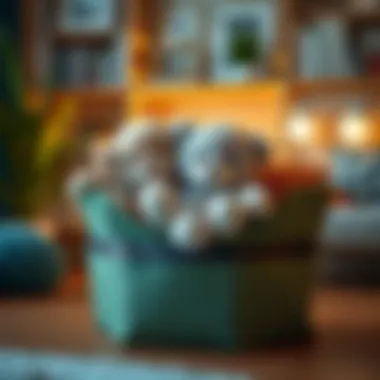

For additional information on cleanliness practices, you can refer to the resources available at Wikipedia or CDC on best practices for cleanliness and organization.
The Aesthetic Aspect of Stuffed Animal Storage
When choosing a stuffed animal bin, aesthetics play a crucial role beyond mere visual appeal. In the world of home organization, the right bin can be as much about function as it is about style. Here, the aesthetic aspect of stuffed animal storage is not just decoration; it cultivates an inviting atmosphere and reflects personal taste, making the space more inviting and harmonious.
An aesthetically pleasing stuffed animal bin can transform a cluttered room into a cozy sanctuary. Think of it not as a storage solution but as an integral piece of decor that enhances your child’s room or play area. For parents and designers alike, understanding how color, texture, and form can influence a space is essential. A practical yet stylish bin can serve as a focal point or complement the overall design theme.
Color Schemes and Patterns
Color schemes and patterns play a vital role in the selection of stuffed animal bins. The color palette can evoke different emotions and set a particular mood within a room. For example, soft pastels can create a calming and soothing ambiance, which is perfect for nurseries. In contrast, vibrant colors can spark joy and energy, ideal for playrooms.
When considering patterns, options range from whimsical prints like animals or stars to more refined geometrics or floral motifs. Each choice carries the potential to reinforce a room’s theme:
- Playful patterns can speak to creativity and imagination, ideal for children.
- Subtle prints often provide a chic touch, suiting more sophisticated décor.
- Matching color themes between the bins and existing décor can seamlessly blend storage solutions with furniture or wall colors, creating a cohesive look.
Ultimately, the choice of colors and patterns should resonate with the inhabitants of the space. A bin in harmony with the environment becomes a cherished part of the room rather than just another object to manage.
Complementing Room Themes
In a world where interior design trends evolve rapidly, incorporating stuffed animal storage that complements room themes is paramount. A well-designed room carries a narrative—each piece tells a story, and a stuffed animal bin should fit right into that tale.
Integrating the bin into the room’s theme requires attention to detail:
- Modern Minimalism: Opt for bins that embrace clean lines and neutral colors, allowing them to blend into sleek décor without distraction.
- Bohemian Styles: Choose bins with vibrant prints or natural materials, such as woven baskets, that add depth and variety to layered spaces.
- Classic Aesthetic: Wooden or upholstered bins with elegant fabrics can add a touch of sophistication to traditional settings, merging functionality with timeless charm.
Consider this: a stuffed animal bin that adheres to the room's theme not only maintains visual harmony but also reinforces the space's character. It's not just about storage; it's about creating a living environment that feels considered and cohesive.
In essence, the aesthetic aspect of stuffed animal storage is about creating a balance between form and function, engaging both the practical needs of parents and the imaginative spirit of children.
User-Centric Design
Designing stuffed animal bins with the user in mind is a crucial aspect that can’t be overlooked. Understanding what families and children truly need enhances functionality, making everyday life smoother. User-centric design isn’t just about aesthetics; it’s about creating solutions that fit seamlessly into the routines of those who will use them. Here, it’s essential to consider how ease of access, safety, and practicality work together to create not just an appealing space but one that works effectively.
The benefits of adopting a user-centric approach are manifold. One significant advantage is that it fosters a more organized living environment, ultimately promoting harmony in a space often filled with chaos. A well-thought-out stuffed animal bin can act as the central hub for toys, dramatically reducing clutter and making clean-up a breeze. Furthermore, thoughtful storage solutions help to develop children’s responsibility regarding their belongings, nurturing ownership and keeping their shared spaces tidy.
Understanding User Needs
Understanding user needs is foundational to designing effective stuffed animal bins. Every household has its own unique quirks—age of children, the volume of stuffed animals, and how involved kids are in their own tidying process. This diversity means one size doesn't fit all. Take, for example, a family with toddlers; bins need to be accessible without being overbearing, allowing little hands to reach in and enjoy their toys.
Here are a few aspects to consider:
- Height: Choose a bin that sits low to the ground for smaller children, enabling them to retrieve their toys without assistance.
- Shape: Consider round or gently contoured shapes; these designs can prevent sharp corners, making safety a priority.
- Color and Design: Bright colors and fun themes can resonate better with children. Incorporating familiar characters can make organization feel less like a chore.
All these elements create a bin that feels tailor-made to the user’s experience, embedding both fun and function into the mix.
Creating a Child-Friendly Environment
Creating a child-friendly environment is about simplifying access while ensuring safety. It’s not just about what looks good—it’s about what works well in a home filled with children who are continuously exploring and expanding their imaginations.
When designing bins for children, consider:
- Material Safety: Look for non-toxic materials that withstand wear and tear, ensuring they are free of harmful chemicals. This is vital not just for aesthetics but for the very health of your little ones.
- Ease of Use: Avoid complicated openings. Bins with easy-lift tops or basket-like structures can make it easier for kids to grab what they need without frustration.
- Visibility: Transparent or partially open bins allow kids to see what toys are inside, encouraging them to engage and play instead of getting overwhelmed by the idea of digging.
"The greatest impact comes when kids feel a sense of ownership over their space. When things are accessible and organized, they thrive."
By embedding user needs along with child-friendly elements into the design process, stuffed animal bins turn into much more than mere storage—they become integral parts of children’s play and organization, ultimately enhancing the quality of life for families.
Epilogue
In wrapping up our exploration of stuffed animal bins, we emphasize how crucial it is to consider design elements that reflect both functionality and aesthetics. A thoughtfully crafted bin serves multiple purposes; aside from storing beloved toys, it can enhance the overall room decor and create a tidy environment. The right design ensures that everything has its place, making it simpler for children, and even adults, to maintain organization.
Summary of Key Points
To summarize, the main takeaways from this article include:
- Understanding the Role: Stuffed animal bins are not just containers; they contribute to a child's development by teaching organization and care.
- Types of Bins: Different materials like fabric, wood, and plastic each bring unique benefits, suited for various spaces and user needs.
- Material Considerations: Prioritize durability, safety, and aesthetics when choosing materials that can withstand wear and tear while still looking good in your home.
- Design Trends: Minimalism, eco-friendliness, and multifunctionality are increasingly important in modern designs. Incorporating these aspects can make a bin more appealing and versatile.
- Practical Tips: Strategies like utilizing labels and sorting by size not only streamline organization but also make cleaning up more intuitive.
Future Trends in Stuffed Animal Storage
As we look ahead, we see several exciting trends transforming the landscape of stuffed animal storage. One notable direction points towards smart storage solutions that integrate technology for better management. Imagine bins with built-in sensors that alert parents when certain toys are missing, helping streamline cleanup.
- Sustainability is also taking center stage. More designers are opting for recycled materials, which not only supports environmental causes but also appeals to eco-conscious parents.
- Alongside, customization options are on the rise. Parents might seek bins that reflect their child's personality, with designs that can be easily changed as their tastes evolve—think removable covers or interchangeable accents.
- Finally, interactive elements within bins, such as compartments that double as play areas or educational features, are becoming more popular. This is not only practical, but it adds a layer of engagement that encourages kids to take ownership of their toy organization.
Overall, the journey into ideal stuffed animal bins reveals a blend of style, safety, and practicality that resonates with modern households. By keeping current trends and user needs in mind, homeowners can transform a simple storage solution into a vibrant part of their living spaces.
"In the world of stuffed animal storage, creativity and functionality go hand in hand. The evolution of design will ensure that every child's cherished toys are not just stored, but celebrated."
For more insights on storage solutions and home organization, you might find resources like Britannica or educational insights at Wikipedia helpful.


